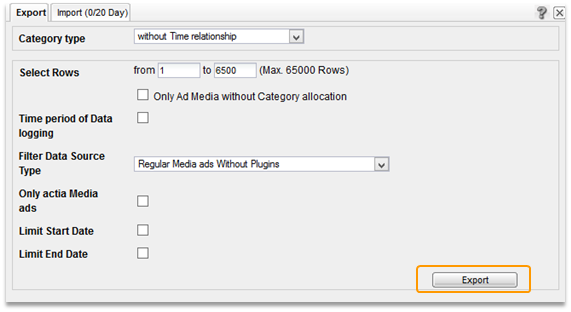- 4 Minutes to read
- Print
- DarkLight
Tracking external marketing campaigns with URL parameters
- 4 Minutes to read
- Print
- DarkLight
This article shows you, how to track external marketing campaigns with URL parameters. Based on a specific example it is depicted, how you can quickly define and evaluate a campaign in Mapp Intelligence.
Extended information on campaign configuration and analysis can be found in the corresponding training chapters.
Campaign tracking
In our example, we are going to track a banner, which links to our website via external sites.
To be able to track this banner, a media code (URL parameter) needs to be attached to the target URL of the banner. Furthermore, the target page (landing page) must be tracked with Mapp Intelligence.
Media code
Any media code can be selected. However, using a standard parameter for all campaigns is highly recommended.
For our banner we are using the media code "wt_mc=display.30_off.dark".
In our example the media code value consists of 3 parts, each separated by a dot. If we use automatic campaign tracking, each of the parts can be analyzed later on the campaign tree.
This parameter is appended to the target URL with a question mark.
Example
Target URL of the banner | Target URL of the banner with media code |
|---|---|
http://www.knigge.com/seminar.htm | http://www.knigge.com/seminar.htm?wt_mc=display.30_off.dark |
If the URL already contains a parameter, use the "&" symbol to insert the Mapp Intelligence media code.
Example
Target URL of the banner | Target URL of the banner with media code |
|---|---|
http://www.knigge.com/seminar.htm?mc=verA | http://www.knigge.com/seminar.htm?mc=verA&wt_mc=display.30_off.dark |
Activating campaign tracking
There are 2 ways to track campaigns in Mapp Intelligence.
Automatic tracking
Manual tracking
Automatic tracking
It is worth tracking campaigns automatically. If additional banners are to be activated in the future, they will be added as new ad media without any further actions necessary.
In Mapp Q3 click on Configuration > Marketing Configuration. Then click New Channel in the tab Automatic Ad Media Tracking.
We configure the channel as follows (only the adjusted fields are explained):
After saving you will see the channel that has just been created:
Manual tracking
Alternatively, you can create each additional media code manually as a new ad media. This is worthwhile above all when the media code does not contain any information, which should be displayed later on in the campaign tree.
In our example, we use the media code "wt_mc=4711".
In Mapp Q3 click on Start > New ad media. We configure the ad media as follows (only the adjusted fields are explained):
After saving you will see the ad media, which has just been created, within the campaign structure.
Alternatively, you can also create ad media using an Excel import. Further information can be found in training chapter Campaign Configuration.
Analyzing campaigns
As soon as the first campaign click (invocation of target URL with media code) has been tracked, the campaign will be visible in all respective analyses.
Please note that new data is updated at an hourly rate. This leads to a delay between the campaign click and its visibility in the analysis.
A detailed explanation of possible analyses and key figures can be found in the training chapter Campaign Analyses.
Editing campaigns
Campaigns and ad media can be edited via the marketing configuration (Mapp Q3 > Configuration > Marketing Configuration).

Campaign structure
The tab "Campaign structure" shows all ad media that have been created. Campaigns and ad media can be edited using the right mouse button. This allows for changing the name or the assignment to individual folders (campaign categories).
Excel Import/Export
Excel imports/exports are extremely useful when editing multiple ads/campaigns.

Click on "Import and Export". Then on the tab "Export" click "Export".

You will receive an Excel file. All adjustments to ads/campaigns can be completed in this file.

Import the adjusted file.
Changes to existing analyses will not be visible until after the next data update.
Analysis of goal achievement
Campaigns are generally used to achieve a specific goal. Please keep in mind to evaluate campaign performance based on desired outcomes, not only clicks/visits/impressions.

Website goals
In Mapp Intelligence the goal "Order" is predefined. If you track orders (e.g. in the section Mapp Intelligence > E-Commerce > Individual orders), those can be analyzed in a campaign context.
Alternatively, other goals can be defined as website goals (e.g. newsletter subscriptions, registrations).
The achievement of website goals can be analyzed across multiple visits.
In our example, the booking of a Knigge seminar is tracked as an order.
Attribution
If a user uses multiple campaigns, the issue arises as to which campaign resulted in the achievement of a website goal. Mapp Intelligence supports multiple attribution models.
Often the last tracked campaign should be viewed as the conversion transformer. In the marketing configuration, this is set as the default.![]()
You can also determine which campaigns should be taken into consideration for the attribution modeling.
If – as in the example – "Direct entry" has not been activated, this campaign will not be considered as the conversion transformer for the website goal.
If you use e-commerce key figures (in the example conversion rate, qty of orders, order value, and avg. order value) in the campaign analysis, these will always be calculated using the default attribution.
Analysis: Individual analysis
In our example, "Bing" was used as the last campaign before the order in 121 conversions.
Customer journey
Customer journey analyses show the sequence of campaign contacts before achieving a website goal. Ad media or traffic sources can be analyzed for this purpose.
Analysis: Marketing > Customer journeys > Ad Media Path
Analysis: Marketing > Customer journeys > Traffic Sources Path



